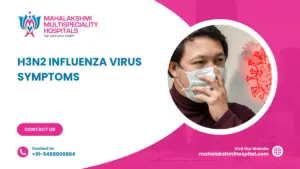The H3N2 virus, a strain of Influenza A, has drawn worldwide concern because of its fast transmission and serious health effects. It is a major cause of seasonal flu, often leading to severe illness in high-risk groups. This overview covers the H3N2 flu, highlighting its key symptoms, available treatments, and strategies to prevent infection.
What is the Influenza A H3N2 Virus?
The Influenza A H3N2 virus is a subtype of the Influenza A virus that primarily targets the respiratory system, causing seasonal flu outbreaks in humans. It emerged from genetic changes in avian and human influenza strains, allowing it to infect people efficiently. This influenza A virus subtype H3N2 evolves rapidly, which can reduce vaccine effectiveness and increase the risk of widespread infection. Common H3N2 influenza virus symptoms include high fever, cough, sore throat, fatigue, and body aches. Severe cases may result in pneumonia or hospitalization, particularly in children and older adults, making continuous monitoring by public health authorities essential.
H3N2 Influenza Virus Symptoms
- High Fever and Chills: Sudden high fever, often reaching 102°F (38.9°C) or higher, accompanied by chills.
- Persistent Cough and Sore Throat: Irritation of the respiratory tract causing dry or productive cough and throat discomfort.
- Body Aches and Fatigue: Muscle and joint pain with prolonged fatigue, even after fever subsides.
- Headache and Nasal Congestion: Sinus pressure and headaches due to inflammation of nasal passages.
- Gastrointestinal Issues: Less common but possible, including nausea, vomiting, and diarrhea, especially in children.
H3N2 Infection Risk Factors
- Age and Weak Immunity: Young children, older adults, and immunocompromised individuals are more vulnerable.
- Chronic Health Conditions: Conditions like asthma, diabetes, heart disease, or lung disorders increase severity risk.
- Pregnancy: Changes in immune and lung function make pregnant women more susceptible to complications.
- Crowded Environments: Schools, offices, and public transport facilitate rapid viral spread.
- Lack of Vaccination: Skipping annual flu shots increases susceptibility to severe H3N2 influenza virus symptoms.
Method of Spread
- Airborne Transmission: Virus spreads through droplets when infected individuals cough, sneeze, or speak.
- Surface Contamination: Virus can survive on surfaces, entering the body when hands touch the face.
- Close Contact: Hugs, handshakes, or sharing utensils can transmit the virus.
- Environmental Factors: Cold, dry conditions enhance viral survival and transmission indoors.
Diagnosis of H3N2 Influenza
Diagnosing H3N2 requires clinical evaluation and laboratory testing. Common methods include:
- Rapid Influenza Diagnostic Tests (RIDTs): Detect viral antigens quickly but may have lower accuracy.
- RT-PCR Tests: Detect viral RNA with high precision, considered the gold standard.
- Viral Culture: Used for research and monitoring circulating types of H3N2 virus.
Early diagnosis ensures effective treatment, reduces complications, and prevents community spread.
Treatment of H3N2 Influenza
- Antiviral Medications: Drugs like oseltamivir, zanamivir, peramivir, and baloxavir can shorten symptom duration if taken early.
- Supportive Care: Rest, hydration, and fever-reducing medications such as acetaminophen or ibuprofen. Avoid aspirin in children.
- Hospital Care: Severe cases may require oxygen therapy, IV fluids, or ventilation. Antibiotics may be used if bacterial infections occur.
- Preventive Antivirals: Recommended for high-risk groups after exposure.
- Vaccination: Annual flu shots remain the most effective defense against severe illness.
Precautions to Prevent Transmission
- Respiratory Hygiene: Wear masks in crowded spaces, cover coughs, and sneeze into tissues or elbows.
- Handwashing and Surface Cleaning: Wash hands for 20 seconds, use sanitizers, and disinfect frequently touched surfaces.
- Self-Isolation: Stay home at first signs of illness, monitor influenza A H3N2 virus symptoms, and avoid gatherings until fully recovered.
- Vaccination and Antivirals: Ensure seasonal flu shots and consider antiviral prophylaxis for high-risk individuals.
- Ventilation and Crowding: Improve airflow indoors and reduce occupancy in enclosed spaces.
Conclusion
Awareness of the H3N2 influenza virus, its symptoms, and transmission methods is vital for personal and community health. Prompt diagnosis, vaccination, and preventive measures reduce complications, limit outbreaks, and protect vulnerable populations. Recognizing influenza A H3N2 virus symptoms early ensures timely care and faster recovery.
Read also: Breast Cancer Treatment





